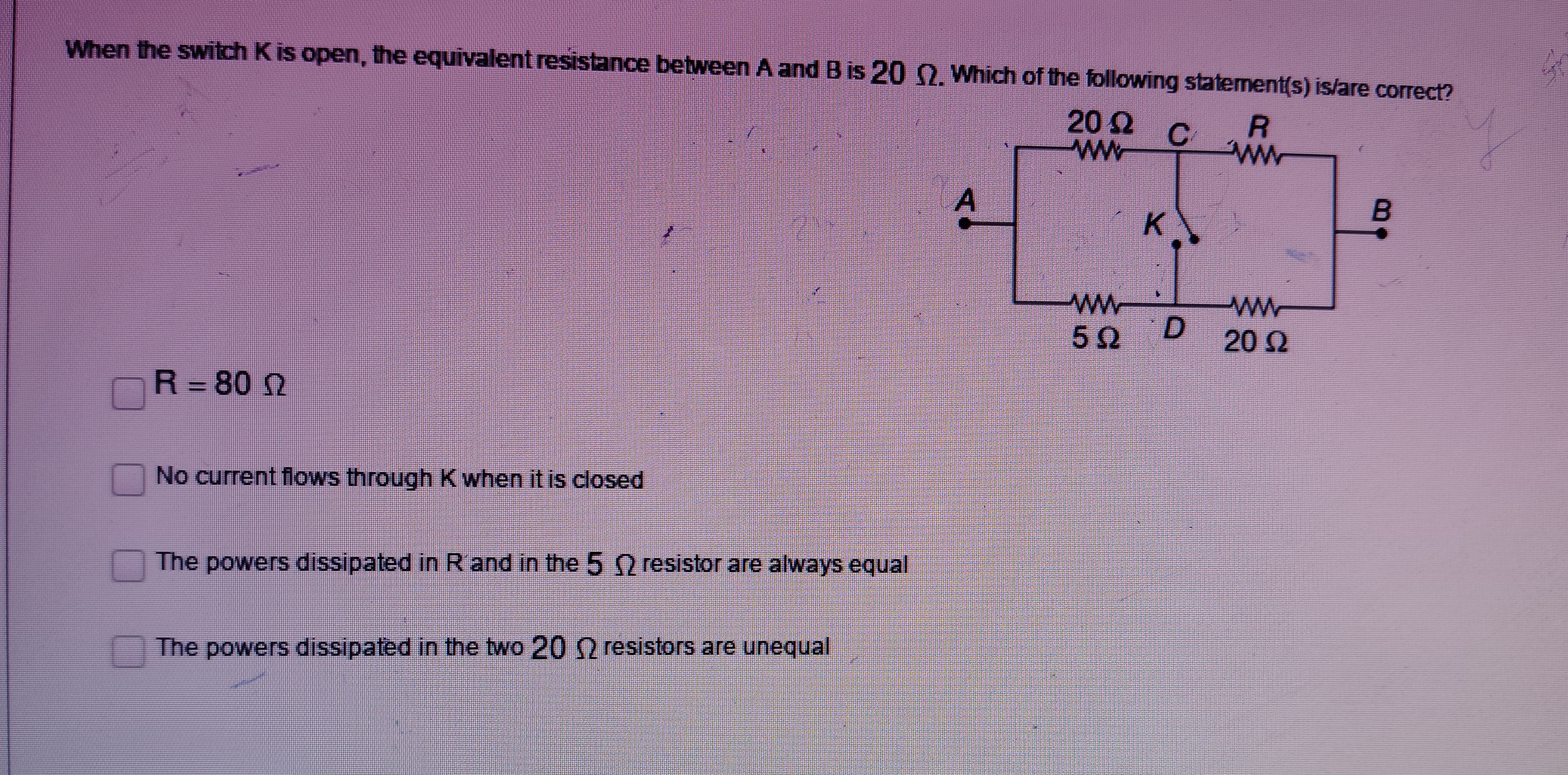Question
Question: When the switch K is open, the equivalent resistance between A and B is 20 $\Omega$. Which of the fo...
When the switch K is open, the equivalent resistance between A and B is 20 Ω. Which of the following statement(s) is/are correct?

R = 80 Ω
No current flows through K when it is closed
The powers dissipated in R and in the 5 Ω resistor are always equal
The powers dissipated in the two 20 Ω resistors are unequal
R = 80 Ω, No current flows through K when it is closed, The powers dissipated in R and in the 5 Ω resistor are always equal, The powers dissipated in the two 20 Ω resistors are unequal
Solution
The circuit consists of two branches connected in parallel between points A and B. The upper branch has a 20 Ω resistor in series with resistor R. The lower branch has a 5 Ω resistor in series with a 20 Ω resistor. The switch K connects the junction C between the 20 Ω and R in the upper branch to the junction D between the 5 Ω and 20 Ω in the lower branch.
When the switch K is open, the circuit is a parallel combination of the upper branch and the lower branch. The resistance of the upper branch is Rupper=20+R. The resistance of the lower branch is Rlower=5+20=25Ω. The equivalent resistance between A and B when K is open is given as 20 Ω. RAB1=Rupper1+Rlower1 201=20+R1+251 20+R1=201−251=1005−4=1001 20+R=100 R=80Ω. So, the first statement "R = 80 Ω" is correct.
Now, let's consider the case when the switch K is closed. The circuit is a Wheatstone bridge with resistances RAC=20Ω, RCB=R, RAD=5Ω, and RDB=20Ω. The switch K is connected between C and D. For no current to flow through the switch K when it is closed, the bridge must be balanced. The condition for a balanced Wheatstone bridge is RADRAC=RDBRCB. Substituting the values, we get 520=20R. 4=20R R=4×20=80Ω. Since we found R = 80 Ω from the given information, the bridge is balanced when K is closed. In a balanced Wheatstone bridge, the potential at points C and D is equal, so no current flows through the switch K when it is closed. So, the second statement "No current flows through K when it is closed" is correct.
Now let's examine the third statement: "The powers dissipated in R and in the 5 Ω resistor are always equal". We need to check this for both cases: K open and K closed. When K is open, R = 80 Ω. The upper branch resistance is 20+80=100Ω. The lower branch resistance is 5+20=25Ω. Let V be the potential difference between A and B. Current through the upper branch Iupper=100V. Current through the lower branch Ilower=25V. Power dissipated in R: PR=Iupper2R=(100V)2×80=10000V2×80=1000080V2=125V2. Power dissipated in 5 Ω: P5Ω=Ilower2×5=(25V)2×5=625V2×5=6255V2=125V2. So, when K is open, PR=P5Ω.
When K is closed, the bridge is balanced, so no current flows through K. The currents through the upper and lower branches are the same as when K is open for a given potential difference V between A and B. Current through the upper branch Iupper=20+80V=100V. Current through the lower branch Ilower=5+20V=25V. Power dissipated in R: PR=Iupper2R=(100V)2×80=125V2. Power dissipated in 5 Ω: P5Ω=Ilower2×5=(25V)2×5=125V2. So, when K is closed, PR=P5Ω. Since the powers are equal when K is open and when K is closed, the powers dissipated in R and in the 5 Ω resistor are always equal. So, the third statement "The powers dissipated in R and in the 5 Ω resistor are always equal" is correct.
Now let's examine the fourth statement: "The powers dissipated in the two 20 Ω resistors are unequal". There is a 20 Ω resistor in the upper branch and a 20 Ω resistor in the lower branch. When K is open, R = 80 Ω. Current through the upper branch Iupper=100V. Power dissipated in the upper 20 Ω resistor is P20Ω,upper=Iupper2×20=(100V)2×20=10000V2×20=1000020V2=500V2. Current through the lower branch Ilower=25V. Power dissipated in the lower 20 Ω resistor is P20Ω,lower=Ilower2×20=(25V)2×20=625V2×20=62520V2=1254V2=50016V2. Since 500V2=50016V2 (for V=0), the powers are unequal when K is open.
When K is closed, the currents are the same as when K is open. Power dissipated in the upper 20 Ω resistor is P20Ω,upper=Iupper2×20=500V2. Power dissipated in the lower 20 Ω resistor is P20Ω,lower=Ilower2×20=50016V2. The powers are unequal when K is closed. Since the powers are unequal when K is open and when K is closed, the powers dissipated in the two 20 Ω resistors are always unequal. So, the fourth statement "The powers dissipated in the two 20 Ω resistors are unequal" is correct.
All four statements are correct.
